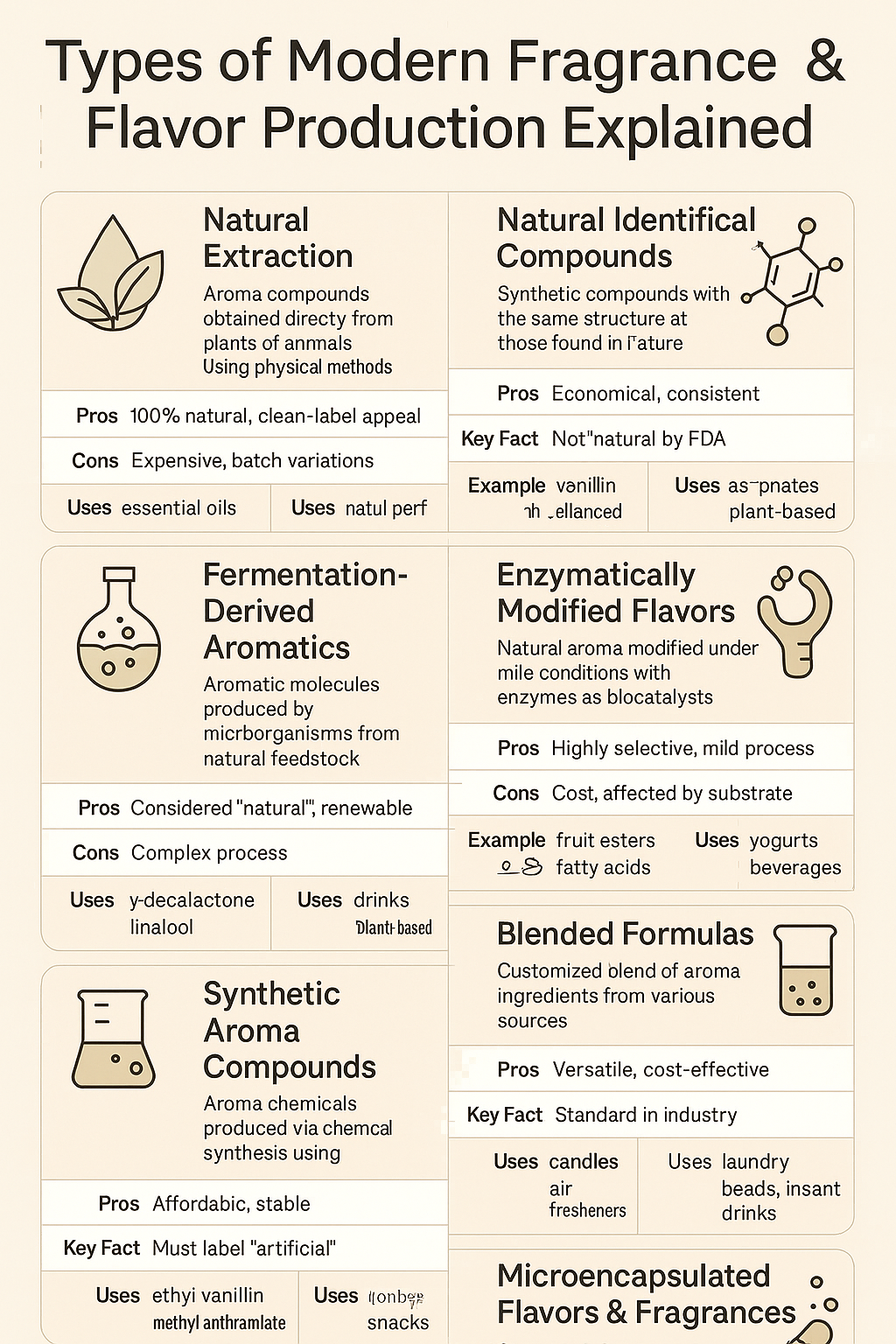🌿 7 Types of Modern Fragrance & Flavor Production Explained
In today’s fast-evolving world of flavors and fragrances, the term “natural” is no longer the only benchmark of quality. Whether it’s the soothing aroma in a luxury perfume, the fruity burst in your favorite candy, or the comforting flavor of vanilla in a dessert — the science behind these sensory experiences has become increasingly sophisticated.
This article explores the 7 primary types of modern fragrance and flavor production, their technical characteristics, and real-world applications.
🧪 1. Natural Extraction
Definition: Natural extraction involves the physical separation of aroma compounds from plants or animals through non-chemical methods like steam distillation, cold pressing, or CO₂ supercritical extraction.
Common examples:
- Lemon oil (cold-pressed from peel)
- Rose essential oil (steam-distilled from petals)
- Vetiver root extract
Pros:
- 100% natural origin
- Highly marketable for clean-label claims
- Preferred in aromatherapy and natural cosmetics
Cons:
- Expensive, climate-dependent
- Aroma consistency varies by batch
- Prone to oxidation and limited shelf life
Best for: Essential oils, natural perfumes, premium beverages, therapeutic applications
🧬 2. Natural Identical Compounds
Definition: These are synthetically produced aroma compounds that are químicamente idénticos to those found in nature. Though made in labs, their molecular structure is the same as their natural counterpart.
Example: Vanillin (the main component of vanilla flavor), synthesized from guaiacol or lignin.
Key Facts:
- Accepted as “natural-identical” in EU regulations
- Not allowed to be labeled as “natural” in FDA (USA) guidelines
- More affordable and consistent than natural extracts
Used in: Flavored yogurts, bakery products, mainstream perfumes
🧫 3. Fermentation-Derived Aromatics
Definition: These are aroma compounds biosynthesized using microorganisms such as yeast, bacteria, or fungi. The microbes convert natural feedstocks like glucose, corn syrup, or plant oils into fragrant molecules.
Popular fermentation-derived compounds:
- R-(–)-Linalool
- Natural vanillin from ferulic acid
- γ-Decalactone (peach-like aroma)
Advantages:
- Considered “natural” under EU and US regulations
- Environmentally friendly and renewable
- Batch-to-batch consistency with scalable output
Common uses: Functional drinks, plant-based foods, natural cosmetics
⚗️ 4. Enzymatically Modified Flavors
Definition: This method uses enzymes as biocatalysts to transform naturally derived molecules into desired flavor compounds under mild, eco-friendly conditions.
Typical applications:
- Converting alcohols to esters (fruity notes)
- Modifying fatty acids to creamy or dairy-like flavors
- Mimicking ripened fruit aroma
Benefits:
- High selectivity, minimal byproducts
- Lower temperature and energy use than synthetic chemistry
- Potential for “natural” labeling if the substrate is natural
Used in: Yogurts, fruit-based beverages, infant foods, dairy-alternative products
🧫 5. Synthetic Aroma Compounds
Definition: Fully synthetic compounds made through chemical synthesis, typically from petrochemical feedstocks.
Examples:
- Ethyl vanillin (stronger than vanillin)
- Methyl anthranilate (grape flavor)
- Iso E Super (used in perfumery)
Why use synthetic flavors?
- Affordable, scalable, and highly stable
- Customizable for novel scent profiles
- Used where natural sourcing is impractical
Regulatory status: Must be labeled as “artificial flavor” or “fragrance” depending on jurisdiction
Common in: Mass-market perfumes, snacks, sodas, household products
🎨 6. Blended Formulas (Composite Flavors & Fragrances)
Definition: These are custom formulations created by combining various natural, natural-identical, and/or synthetic compounds to produce a desired aroma profile.
Features:
- Can mimic complex natural odors (e.g., “fresh-cut grass,” “white musk”)
- May contain dozens to hundreds of ingredients
- Standard practice in commercial flavor and fragrance development
Advantages:
- Highly flexible and performance-optimized
- Enables cost, stability, and sensorial customization
- Essential for developing top/middle/base notes in perfumery
Used in: All consumer goods sectors — from food to air fresheners
🧴 7. Microencapsulated Flavors & Fragrances
Definition: This is not a production method for the aroma itself, but a delivery system in which flavors or fragrances are encapsulated in microcapsules (e.g., starch, gelatin, or polymers).
Function:
- Protects aroma from heat, light, oxidation
- Enables controlled or time-release of aroma (e.g., burst while chewing, or in wash cycles)
Examples:
- Fragrance beads in laundry detergents
- Flavor capsules in chewing gum or instant drinks
- Shelf-stable flavor sachets for instant noodles
Benefits:
- Extended shelf life
- Reduced volatility
- Ideal for long-distribution consumer goods
🧠 Choosing the Right Type for Your Application
| Goal / Use Case | Best Type(s) Recommended |
|---|---|
| 💄 Luxury cosmetics / aromatherapy | Natural Extraction, Enzymatic |
| 🍹 Beverage flavors | Fermentation-Derived, Blends |
| 🧼 Detergents, soaps | Synthetic, Encapsulated |
| 🍬 Candy, snacks | Synthetic, Natural Identical |
| 🧃 Clean-label foods | Natural Extract, Fermented |
| 🍼 Infant and medical nutrition | Enzymatically Modified |
✅ Conclusion: Science & Nature in Harmony
Modern flavor and fragrance manufacturing is no longer just about squeezing oils from flowers or boiling spices. It’s a precise, regulated, and often biotech-driven field. Whether your product calls for a clean-label peach flavor or a long-lasting synthetic musk, there’s a production method built for that need.
By understanding the seven core types of aroma production, brands and consumers alike can make informed, intentional, and sustainable choices in how scent and flavor shape their experiences.

